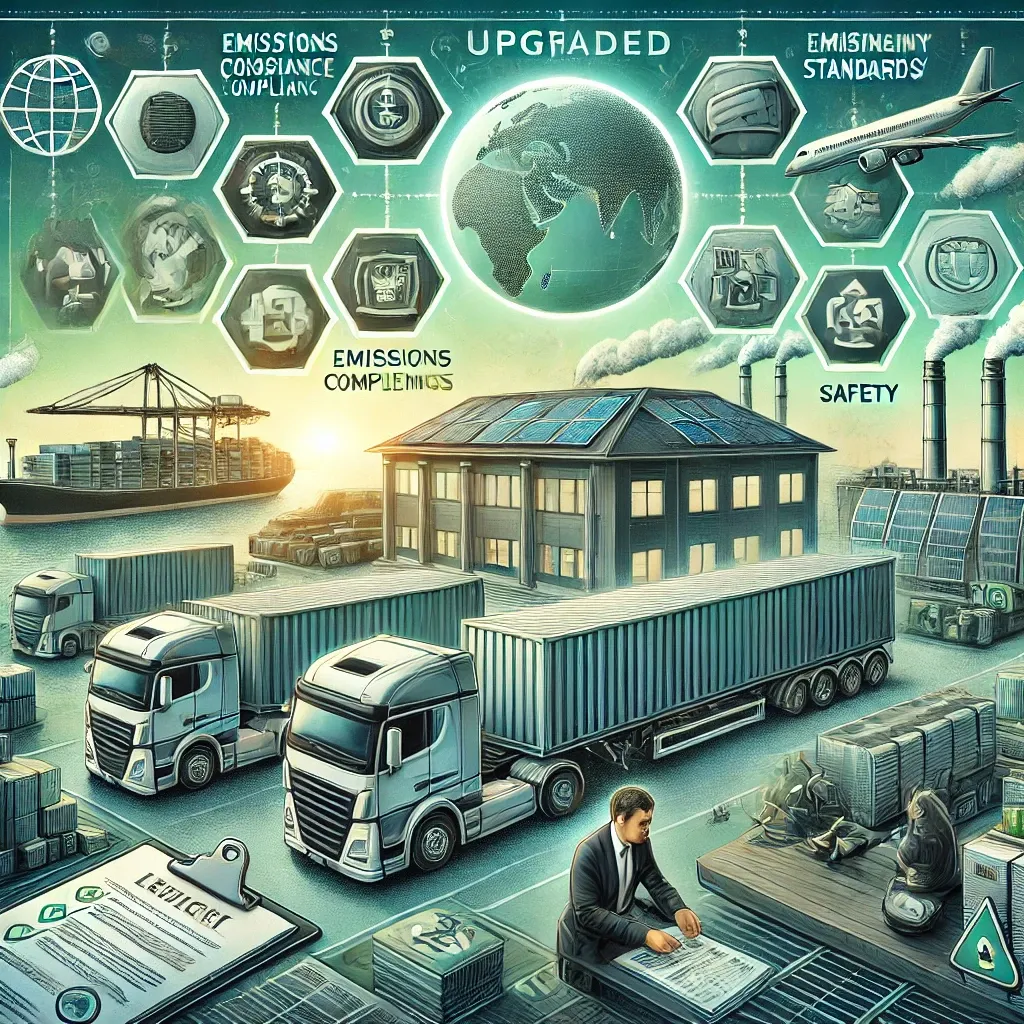
The transportation and logistics industry operates in a dynamic regulatory environment, with evolving rules on emissions, safety, and labor practices shaping its operations. These changes, while necessary for fostering sustainability, safety, and fair labor standards, also add layers of complexity and financial burden. Companies must navigate these challenges proactively to remain compliant and competitive in a rapidly transforming landscape.
The Scope of Regulatory Changes
- Emissions Standards
- Environmental concerns have led to stricter regulations aimed at reducing carbon footprints. Many governments now mandate lower emissions from transportation fleets, pushing companies to transition to cleaner energy solutions, such as electric or hybrid vehicles.
- These standards are part of broader sustainability goals, aligning with global initiatives like the Paris Agreement to combat climate change.
- Safety Regulations
- New rules often focus on improving driver and vehicle safety, including requirements for advanced driver assistance systems (ADAS) and electronic logging devices (ELDs).
- Companies must invest in training drivers to comply with updated safety protocols and utilize technology to monitor and enforce safe driving behaviors.
- Labor Practices
- Regulations addressing work hours, wages, and conditions are becoming increasingly stringent to protect workers’ rights and improve job satisfaction.
- The industry faces added challenges with ensuring compliance while managing costs associated with improved labor practices.
The Impact on Operations
- Financial Investments
- Compliance requires significant capital expenditure on modernizing fleets, implementing advanced technologies, and upgrading infrastructure.
- For example, transitioning to electric vehicles (EVs) entails purchasing new equipment, installing charging infrastructure, and training personnel on EV maintenance.
- Operational Complexity
- Adhering to diverse regulations across regions complicates cross-border logistics. Companies must ensure compliance with multiple jurisdictions, which may have differing standards.
- This complexity requires robust management systems and specialized legal and regulatory expertise.
- Market Dynamics
- Non-compliance risks include fines, reputational damage, and restricted market access. Companies that fail to adapt to new regulations may lose contracts or face increased scrutiny.
Strategies for Compliance and Adaptation
- Investing in Technology
- Companies are turning to digital tools like telematics, fleet management software, and AI-powered analytics to ensure compliance with emissions and safety regulations.
- Blockchain technology is also being explored for its potential to improve transparency and traceability in regulatory reporting.
- Modernizing Fleets
- Transitioning to cleaner energy solutions, such as EVs, hydrogen-powered vehicles, and biofuels, is critical for meeting stricter emissions standards.
- Retrofitting older vehicles with emissions-reduction technology offers a cost-effective interim solution for some operators.
- Training and Education
- Comprehensive training programs are essential for equipping drivers and staff with the knowledge to comply with new safety and labor regulations.
- Awareness campaigns and regular workshops help keep employees informed about regulatory changes and their implications.
- Collaborating with Stakeholders
- Partnering with industry groups, governments, and technology providers allows companies to stay ahead of regulatory trends and share best practices.
- Advocacy efforts through trade associations can help shape regulations to balance feasibility and impact.
- Adopting Sustainability Practices
- Companies are integrating sustainability into their core operations, not only to meet emissions targets but also to enhance brand value and attract environmentally conscious clients.
- Initiatives such as optimizing routes, consolidating shipments, and reducing waste contribute to both regulatory compliance and cost savings.
The Push Toward Greener Logistics
One of the most significant shifts in the industry is the drive for greener logistics. Governments worldwide are implementing policies to reduce greenhouse gas emissions, such as carbon taxes and incentives for adopting clean energy. While these measures create short-term challenges, they also present opportunities for innovation.
For example, the adoption of electric trucks and autonomous vehicles powered by renewable energy can revolutionize freight transportation. Companies that embrace these advancements not only ensure compliance but also position themselves as leaders in sustainable logistics.
Looking Ahead
Regulatory changes are set to intensify as governments and organizations work toward achieving ambitious environmental, safety, and labor goals. For the transportation and logistics industry, this means continued investment in technology, infrastructure, and workforce development. By embracing these changes, companies can turn regulatory challenges into opportunities for growth, innovation, and enhanced efficiency.
Conclusion
The evolving regulatory landscape in the transportation and logistics industry underscores the need for proactive adaptation. While compliance demands significant effort and investment, it also drives innovation and positions companies for long-term success. By staying informed, adopting advanced solutions, and fostering collaboration, businesses can thrive in a world where regulation and progress go hand in hand.
Jenny is a business insurance broker with Waypoint Insurance. She can be reached at 604-317-6755 or jhansen@waypoint.ca
Jenny Holly Hansen is a cohost with Chris Sturges of the Langley Impact Networking Group. You are welcome to join us on Thursday’s from 4pm to 6pm at: Sidebar Bar and Grill: 100b - 20018 83A Avenue, Langley, BC V2Y 3R4
Jenny Holly Hansen is a cohost with Chris Sturges of the WRN News - Langley Edition
Tags: #Langley Impact Networking #Industry Insights #Transporation and Logistics #Supply Chain Disruption #Rising fuel Costs # Driver Shortages #Jenny Holly Hansen

